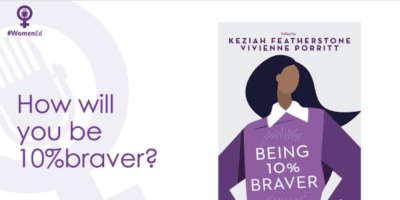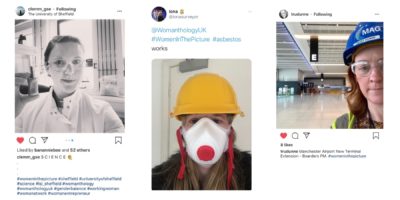Andra Salcudean is a digital designer and video editor at Labster, a fast-growing company that creates virtual simulations of scientific laboratories, which empowers students to learn and practice laboratory work like they would in real labs. Andra supports sales and lead generation with videos, animations, whitepapers, brochures, SoMe artwork, email banners, infographics, and conference booth design. She also has participated in user experience design projects and helped drive a company-wide rebranding project.

“For many students there’s a very limited amount of opportunities to use expensive lab equipment to perform experiments and gain practical experience, and for them Labster is a great alternative, allowing them to understand how the machines actually work and how they will be using them in their careers as scientists.”
Turning my hobby into a career
My education has always revolved/drifted towards design. As a child, I would sit at my small desk in my parents’ apartment until the early hours of the morning (to my mother’s desperation) and click away at illustrations and photo edits.
Back then in my little Romanian hometown, the Internet was expensive, so this was my favourite pass time activity (or favourite way of procrastinating instead of doing homework). Regardless, it paid off: it became one of those things that I just enjoyed doing.
I initially wanted a career as an attorney, but in my teenage years I kept bumping into that quote we’ve all read, that goes something like “do what you love and you’ll never work a day in your life”, so I decided to pursue design instead. I always joke about it being my hobby.
After high school I moved to Copenhagen, and since then I’ve graduated from a multimedia design and communications programme, followed by digital concept development, and finally I’ve pursued a master’s degree in strategic media development.
Labster: the future is here
Labster is an EdTech company that creates virtual lab simulations for science students. Our mission is to empower the next generation of scientists to save the world. Did you roll your eyes reading that? It’s definitely a bold statement, but we live by it, and it’s one of the things that drives us forward.
Virtual labs are like flight simulations, but for scientists. Students can learn lab techniques and get their hands dirty with lab equipment they might not have access to otherwise, because of expenses or other circumstances.
The machines in our virtual labs are designed 1:1 with their real-world counterparts by our incredibly talented (and conscientious) in-house scientists. This makes Labster a great pre-lab tool that enables learners to familiarise themselves with both lab equipment and techniques, which we’ve found increases their confidence when they actually go into a physical lab — they just feel less intimidated.
Labster is also great as a post-lab exercise, to refresh students’ memory or evaluate their knowledge after they’ve been in the lab. We’ve also received great feedback from schools that can’t afford physical labs, and have turned to Labster as an alternative.
One aspect where virtual labs have the upper hand is visualisation of difficult concepts. In many cases, scientific concepts can be abstract and it’s difficult to imagine what happens inside a machine, or in a chemical reaction on a molecular level. Luckily, virtual lab simulations don’t have these limitations, and students are able to see what happens inside lab equipment or even pick up molecules and atoms and spin them around to observe chemical reactions.
My work routine
My role as a digital designer in marketing is to help connect the product with the market while making sure all external materials are kept on brand.
I strive to develop a media strategy and maintain a consistent image of Labster across all platforms, with compelling materials that reach those who need Labster – students, faculty and professionals in the STEM industry.
On a normal day, I start with a coffee, a few ad-hoc design tasks, and then dive into video editing. Each of our laboratories is based on a real-life case, which helps students see the actual application of what they’re learning. I always try to find new ways to reflect the storytelling from our labs in our marketing videos.
On a higher level, I try to see the bigger picture and strategise the use of media in our marketing efforts, to reflect the hard work of our developers, scientists, artists and everyone else in the product team and ensure that Labster reaches those who truly need it.
EdTech rose to the occasion during COVID-19
We’re definitely seeing a spike in interest caused by the pandemic, as more and more institutions are looking to move their science courses online. People who might have been sceptical towards virtual laboratories (which is natural, given that the technology is fairly new and quite disruptive to traditional teaching) are now trying it out. The pandemic caused an acute need for alternatives to wet labs, and during lockdown Labster provided free access for institutions that were in need.
Although it was quite a big leap in the number of students adopting Labster, our customer-facing teams did an amazing job accommodating them, resulting in 85% of students being pleased with their Labster experience, according to our surveys.
Our simulations are currently being played by more than twenty-five thousand students across the world, every single day, and waking up to those metrics empowers me (and I’m sure the rest of the team as well) to keep delivering valuable content for learners and their instructors.
We’re also seeing a great response from students. They really love the animations in the labs and the visualisation of concepts. Teachers report that their students also appreciate the real-life stories. Having a real story, a human component attached to a lab technique is very engaging, and it help students see how they can apply their knowledge in the real world after graduating.
A great alternative
Virtual labs are very adaptable. They can be used both as pre-lab and post-lab exercises, which means it’s up to every teacher to decide where they fit best in their course. Of course, they cannot fully replace the experience of a wet lab, but in schools where wet labs aren’t an option because of cost constraints, Labster can be a great alternative.
Even with physical labs available, time is very limited when it comes to performing experiments, so having virtual labs as a pre-lab exercise ensures time in the actual lab is used at its highest potential. Not to mention that with virtual labs, you can speed up time and an experiment that takes hours or days in a physical lab can be completed in a simulation in a matter of seconds.
Another aspect of it is the actual use of machines in the lab. For many students, there’s a very limited amount of opportunities to use expensive lab equipment to perform experiments and gain practical experience, and for them Labster is a great alternative, allowing them to understand how the machines actually work and how they will be using them in their careers as scientists.
An optimistic future
I believe that the pandemic has forced many institutions, teachers and students alike to adapt to a new online learning environment which has shown incredible results.
EdTech has definitely proved itself during this pandemic, showing that it can facilitate access to education in the most unusual of contexts. It can (and will continue to) empower learners who otherwise wouldn’t have access to lab equipment, and it can provide a cheaper alternative for those who can’t afford it.
It’s been a long and beautiful journey for Labster (and for myself), and seeing the quality of the simulations improve every year has been an incredibly powerful catalyst for us to keep moving forward. We’ll continue to strive to provide access to quality science education to students across the globe.
We stand by our mission—empowering the next generation of scientists to change the world.







